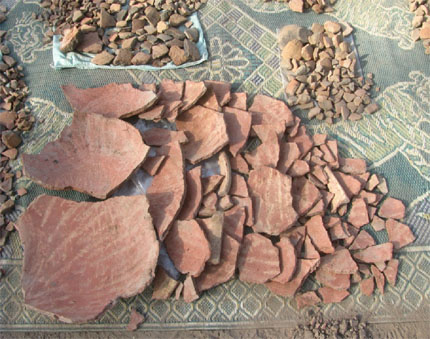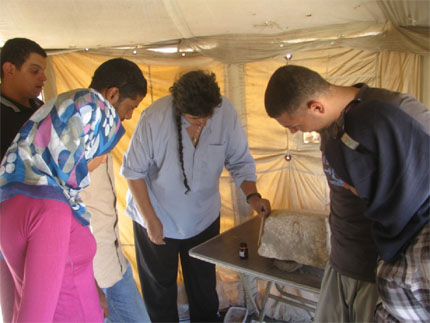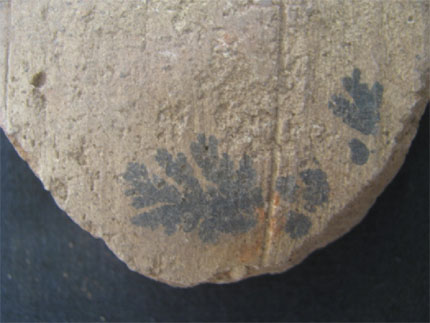Posted by Lamia el-Hadidy, Archaeological field conservator
In the beginning of my career as an archaeological field conservator, I worked here in Kom el- Fakhry just a few meters east of the field school concession, as well as in other projects in Mit Rahina later on. Upon my return to the site this season and meeting old acquaintances from different times, I thought of being “Back to the Future”.
As a conservator, or to be more accurate “field conservator”, you don’t know exactly what you’ll be working on even if you have previous experience in the area. You could have a different period or a different function of the place. And what I have here in Kom el-Fakhry is both a different period and different function of the site. But the objects’ materials are almost the same : pottery, stones, faience, flints….etc.

Pottery to be reassembled. Photo by Lamia el-Hadidy
And here in the site, the ground is dusty and muddy. Sometimes it is dry and sometimes wet, especially as we go deeper in the ground and closer to the under surface water table. We are also lower than the local village, and Memphis suffers deeply from rising underground water. So most of the objects that are found suffer from dampness, and one has to deal with them very slowly to be able to treat and conserve them later. Things have to take their time and one has to be very patient. But there is always a funny conflict between the archaeologists and the conservators, for the former are very impatient and want things to be cleaned and conserved quickly so that they can study them. Conservators need time and cannot be rushed in their work, so that whatever information is there on the object or any archaeological material can be cleared and well preserved for studying.
Understanding the concept of conservation is the main point that I try to get the students of the field school to understand and accept. During the conservation class, the students are introduced to the precautions that should be taken during the excavations to protect the finds or site. Also, they are introduced to the cleaning and adhering of objects and how to identify some of the materials by simple methods.

Showing how to identify limestone. Photo by Yasser Mahmoud

Effect of manganese mineral in the earth on a pottery sherd. Photo Lamia el-Hadidy
In addition, students practice cleaning pottery sherds with brushes (they sometimes think it is a very quick easy matter) and in the end, they realize how conservation is a very delicate job and needs a lot of patience even in the simplest steps, such as cleaning with brushes. During the practical side of the class, we discuss the different problems that they face in their sites and how to deal with them, especially if they do not have a conservator around.
Participating in the field school has its own charm. Besides working on the different archaeological material that comes up from the excavations, you meet new colleagues and reconnect with old ones. And there are always expectations of how will I get along with everyone as there are different backgrounds and mentalities (both Egyptians and foreigners). But in the end, that all disappears and one gains new friendships and new experiences.
